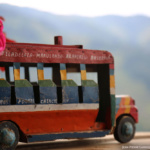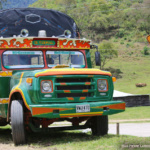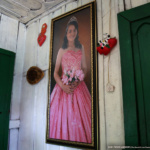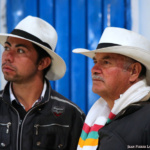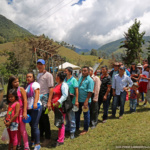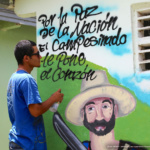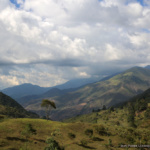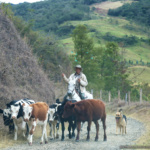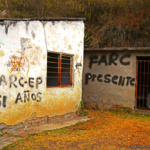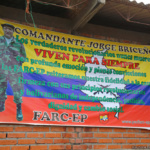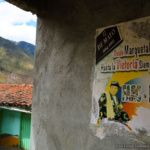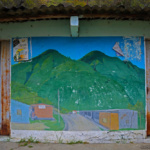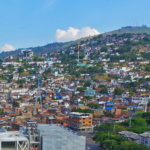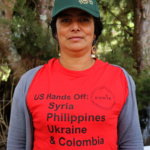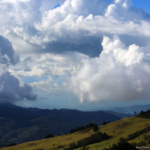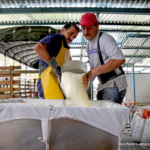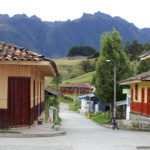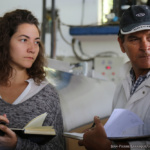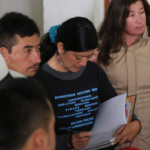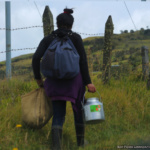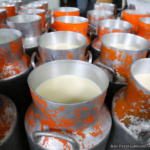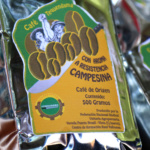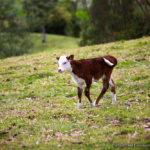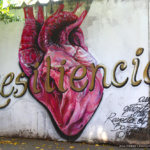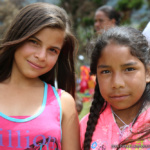Entrada
We’ve been driving up a dirt road since before dawn. As day breaks in the mountains outside of Buga, Colombia we come to the village of El Placer. I’ve journeyed to this area with a small group of NGO workers to learn how economic development projects can sustain the recent peace agreement between the Colombian Government and the Colombian Armed Revolutionary (FARC).
We stop to stretch our legs and my breath lingers like a ghost in the cool mountain air. A school bus pulls up in front of us. It’s a diesel truck with an open back; ancient, ornate, and painted like a rainbow. A few children obediently climb aboard and the caravan barrels down the road. A blast from its horn echoes from the hills in the distance.
The emptiness of the street reveals the open door of a tiny cocina attached to a modest home. We duck into the building and huddle around a table. Above us hangs a weathered portrait of a young girl on her communion day. A woman appears from the kitchen with arepas.
“So when are we going to meet some of the FARC?” A fellow ex-pat colleague asks as mugs of different styles are passed around and filled with coffee.
“Perhaps, some of them are here eating among us,” our guide replies in a gentle, quizzical way.
Our eyes search the room for guerrillas, but no one resembles Che Guevera; no one is wearing camouflage; no one has brought an assault rifle to the breakfast table. There are just a few sleepy, guacho dressed men and women sipping coffee. Yet, the guerillas must be around. This area of Valle de Cauca is controlled by the FARC. At times it has been a battlefield for a civil war that has been waged for over half a century.
Just outside the restaurant in the street where the school bus was parked, our guide tells us that a massacre took place.
“What happened?” I ask.
I learn that in the 1990s, a paramilitary visited El Placer and executed suspected guerillas in front of the entire town’s residents. Another story is told about a jealous FARC leader who disposes of a more handsome guerilla under his command. The stories go on and after a while I can’t keep tally of which side has the most blood on their hands.
My gaze relaxes on cattle grazing in the bucolic hills just beyond the village. It is an idyllic setting for a war and incomprehensible that this is a place of violence. Last week in the same spot, the village put on a fiesta. They boiled an enormous cauldron of chicken stew, children played on a slip and slide, vendors sold dulces, and speeches were given. Teenagers painted on a wall to honor the campesinos, Colombia’s self-proclaimed peasant community, el corazón de las montañas.
The fiesta celebrated the peace agreement signed between the FARC and the Colombian government. Now that war has ended, the campesinos gathered to decide what to do next.
“We just want to come together to build a place where our children will have peace for future generations,” says one of the campesinos as we finish our coffee in the cocina.
Tierra Contesta
We get back in the car and travel further up into the mountains. Colombia is the second most bio-diverse place on Earth. At every switchback of the road, the scenery changes. We drive through dense forest and turn the corner to meet cacti on arid vistas. This is a country of microclimates. At this elevation the conflict starts to make sense.
The steep mountains and primitive infrastructure have made this land difficult for the administrators in Buga’s urban center to govern and easy for the FARC guerillas to defend. Yet, the rural communities that we pass along the road seem frozen in time. Cowboys on horseback lasso cattle out of the road to allow our vehicle to pass. Opportunities for young people are scarce here. Higher education and jobs are elusive.
Government soldiers now patrol this rugged landscape. Despite their weapons and camouflaged uniforms, they seem ant-like and out of place against the lofty vistas. We descend to a hydroelectric dam at a place where two rivers meet. A military camp guards the instillation, dwarfed by the surrounding hills.
Up we climb along the next ridge until we come to a weary outpost overlooking the rivers. A three legged dog limps across the road, followed by a tough looking man in a fluorescent jumpsuit with a machete at his waist. The graffiti on the simple buildings makes it clear that this village is pro-FARC. A wall held up with cardboard looks like it took the brunt of a cannonball. We are told that this was the site of a battle. The FARC commander who defended the crossing is celebrated with glossy, vinyl banners.
I use a pit latrine perched on the side of an escarpment. Walking back to the car, I notice Spanish verses painted on another mural near the graffiti. I recognize it from the bumper stickers that you see on cars around the environmentally conscious parts of the United States.
“When we destroy the last tree on earth, when we finish poisoning the last river of this planet, at that moment we will realize that we can not eat money.
Mesoamerican Indian
Otra Perspectiva
Looking at the inscription reminds me of a conversation I had in Cali earlier that week.
“I admit that I am naïve to the causes of the violence in Colombia,” I tell a group of teenagers I met at a food court of an upscale shopping mall in Valle de Cauca’s capital.
They had asked me what I knew about the war. To me, the conflict is something abstract. I look past the kids to the distant gondolas traversing across the city’s skyline to the favelas on the top of the hills.
“What I do believe,” I continue, “is that conflict can be driven by greed and inequality.”
They nod silently. Whether in agreement or just to move the discussion along, I will never know. The following morning I receive news that one of the boys was mugged and stabbed by petty thugs shortly after our conversation. Luckily, the injuries are minor, but it was a reminder that the war will not end with the stroke of a pen in Havana. Violence is messy.
Money is certainly a root of the atrocity. For the FARC, it came fast and in abundance through drug trafficking, kidnapping, and illegal mining. For the government, it came in the form of generous support from the Americans to combat the guerillas and cocaine. However, I believe that el deniro is simply a tool that can be used for evil or for good. The right type of economic development in rural areas like this one can sustain the Colombian peace process.
We drive on up through the clouds until they are behind us in a valley below. I doze off only to be awoken by a bump in the road. I open my eyes to catch fantastic panoramic views of rustic farms set against towering sierras and then fall back asleep until we hit the next section of washboard track.
El Destino
I come to as we enter San Lucia, a sleepy town in the middle of nowhere. Rich green vegetation contrasts with the red, yellow, and blue homes and shops; painted in the same color scheme as the Colombian flag. Catholic shrines dot the plaza, cows graze in the meadows and children play soccer. Men with ten-gallon hats and thick mustaches peer out of doorways like a scene from a Spaghetti Western. A portrait of Santa Claus is painted in the middle of the road. Nearby, another shiny poster of FARC commanders hangs from a fence.
We have reached our destination. A group of young men and women who live in the area gather around the Santa Claus. They have come to learn about la leche. Behind them men in goulashes and smocks in a dairy pour drums of milk into a vat that separates curds.
As the peace process unfolds in the country, guerilla ex-combatants are surrendering their weapons to the government and enter into transitional camps. The programing at these stations is still being formed, but it is clear that after the disarmament and demobilization, the FARC won’t go back into the jungle. They will have to reintegrate into society and will need jobs.
The young people scribble in notebooks and take photos with their phones of the milk production. The dairy’s staff shows off their equipment and leads them through the refrigerated rooms and laboratory in the building.
“We cannot build peace unless we bet on the initiative that the community has been working on for a long time,” a man tells me as we take the tour.
Campesino leaders have aspired to form a dairy collective for years.
“The communities identified a strategic project to bring the region forward in economic terms, which is a gathering and processing center for milk,” a woman in the group explains.
However, the conflict has created inertia that prevented the project from getting off the ground. The peace agreement brings renewed energy to the endeavor.
The existing market is artisanal at best. Jugs are carried by horse or by hand on daily milk runs of limited reach. The group is now set on building their own processing plant in anticipation of the guerillas that will be returning home and looking for work.
“Many of these people are also peasants that will be re-integrating into civilian life,” the man on the tour says.
With the right tools to store and distribute milk, the young people hope that they can scale up the existing industry and connect these remote mountain communities with larger, more lucrative markets in Buga and Cali.
Realismo Magico
It will be interesting to watch how Colombians will culturally appropriate the humdrum, day-to-day life of peace. All sides have romanticized Colombia’s civil war.
At a music festival in Cali, I observed an enthusiastic crowd gather around to buy toy soldiers representing the Colombian government. Back in my hotel room I watched a television station that played round-the-clock programming of military trainings and maneuvers. In the mountains, I heard love songs about the guerillas. At the Buga fiesta vendors sold bags of coffee emblazoned with Marxist graphics that promise a brew, “con aroma a resistencia campesina.”
In contrast, milk is a wholesome commodity. Processing it is a benign day job that is too ordinary to be featured in any propaganda. Maybe that’s the shift that Colombia needs in this moment in time: a return to normalcy.
“Peace is a thing to be enjoyed. Peace is the moment where things that you could not do because there was a conflict, you will be able to do in the absence of that conflict,” says Juan Fernando Lucio, the director of PASO Colombia, a peace-building organization based in Cali and Medellin. “And I feel that it is a privilege for a country when it can tell the next generation that it was capable of abandoning war.”
Peace in Colombia is not only a single act of diplomacy between the government and the FARC. It is the day-to-day coexistence of these two groups, from their leaders to their supporters. A return to interdependent, daily commerce is its own kind of magical realism. This has the potential to change behavior in a way that creates a new kind of culture for Colombia’s children: one with better opportunities for everyone.
Yet, this can’t be magical thinking. There is already uncertainty about how the reintegration process will play out even as the first ex-combatants handover their arms and enter into transition camps. Projects like the San Lucia dairy need to be replicated on a countrywide scale. Like milk, initiatives like these are good for Colombia’s diet if the country wishes to grow strong.

